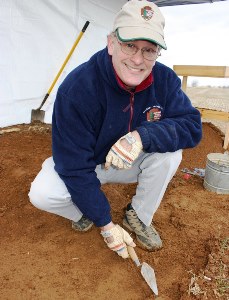Archeologist
National Capital Region (33 park units in Maryland, Virginia, West Virginia, and the District of Columbia)
Responsibilities: The parks in and around our nation’s capital are situated atop the remains of more than 13,000 years of human history, from prehistoric campsites to Civil War battlefields. Potter serves as chief scientific advisor to the NPS regional director on all matters related to archeology. “I look at a how people have used a piece of real estate over time. By the time the Europeans arrived here, the Native Americans in the eastern woodlands were as complex socially and politically as people in Europe.” He also designs and directs archeological surveys and excavations, supervises a lab and curatorial facility, ensures compliance with Federal historic preservation regulations, evaluates sites for inclusion on the National Register of Historic Places, and assesses the effects of proposed park improvements.
Years in current position: 36
Years with the Park Service: 36
Career path: Potter joined the National Park Service after graduate school.
 What makes my parks special:
What makes my parks special: “People have inhabited the Potomac [River] Valley for thousands of years. The Potomac River floods, but it doesn’t wipe the slate clean. Those deposits lay down a protective layer. Then the spot may get used again, leaving more archeological evidence . . . . People don’t expect archeology to survive in such a built-up environment, but nothing is further from the truth.” “No one had done an archeological survey along the 184-mile Chesapeake and Ohio Canal. I had a hunch that humans had gravitated to the water here. When a tributary stream eroded a spot beside the Potomac River, I found stone arrowheads, pottery, and animal bones dating back to 1,500 AD. Three feet down, my team uncovered pits for dry food storage, flint, and evidence of wigwam poles circa 1,000 BC. Six feet down, we discovered a fire pit from 3,800 BC. Eight feet down, we unearthed an atlatl (spear thrower) from 8,500 BC. The site had been used off and on for more than 11,000 years. In addition, it showed changes in the environment based on flooding patterns and changes in flora based on pollen in soil samples.”
Typical day: “Every day is different.”
Biggest challenge: “The resources in 2016 are not the same as they were percentage-wise in 1980. The Park Service tries its best to promote the parks in a way that touches everyone. No one working for the Park Service is getting rich, but they care and have big hearts. The parks mean a lot to all of us.”
Best part of the job: “Doing field work at new sites, then determining if what’s there is significant enough to merit further research. Presenting to the public, especially young people.”
Advice for visitors: “Consider lodging at Canal Quarters — a restored lock house on the Chesapeake and Ohio Canal. It’s a stay back in time.”
Favorite national park: “The Chesapeake and Ohio Canal National Historic Site. It’s a narrow strip but so diverse in terms of its natural and cultural resources, landscapes, and historic sites. It’s enjoyable to see by canoe or you can hike or bike on the towpath.”
Learn more about our national parks! View historic photos, listen to audio on how the film, "Our National Parks: America's Best Idea," was created, and learn about activities and events the park system offers.